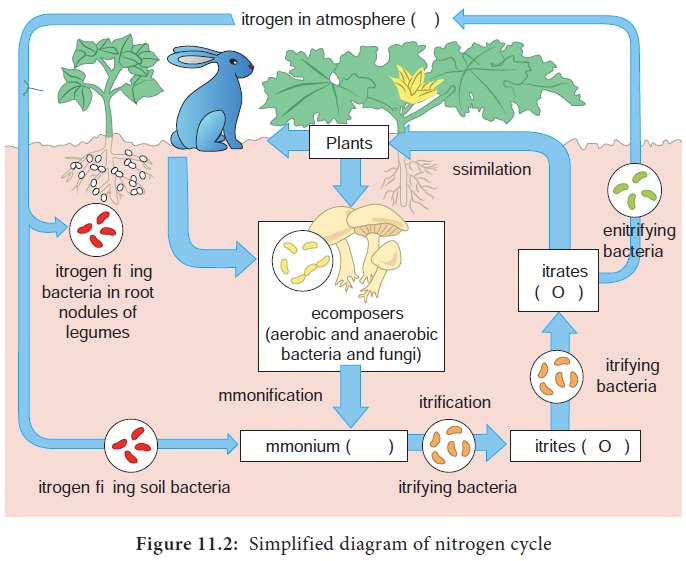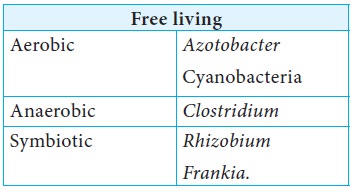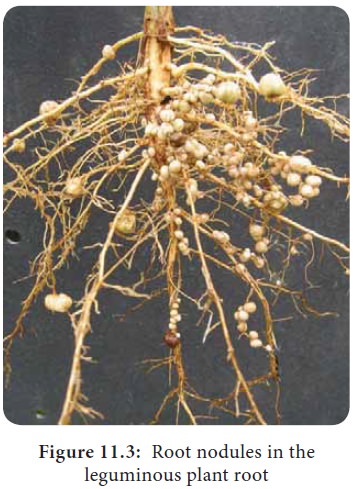different stages or processes - Nitrogen Cycle | 11th Microbiology : Chapter 11 : Agricultural Microbiology
Chapter: 11th Microbiology : Chapter 11 : Agricultural Microbiology
Nitrogen Cycle
Nitrogen Cycle
The element Nitrogen (N) is a key constituent in microbial cell.
Nitrogen is needed for the formation of proteins, amino acids, nucleotides and
is present in a number of oxidation states inside the cell. Nitrogen is cycled
between atmosphere, organic compounds in living things, soil and sediments.
The processes that are involved in Nitrogen cycle are
1.
Nitrogen fixation
2.
Nitrification
3.
Ammonification
4.
Denitrification
Nitrogen fixation
Nitrogen is present as N2 (N ![]() N) in
air (78% N2). The triple bonded state of nitrogen makes it very
stable and nitrogen in its gaseous state cannot be assimilated by plants or
animals for their metabolism. Only few groups of prokaryotes are capable of
breaking the triple bond and use it for building up their proteins and
aminoacids. The process of reduction of gaseous nitrogen (N2) to
ammonia (NH4) is called Nitrogen fixation. This process is carried
out by a group of prokaryotes called diazotrophs.
N) in
air (78% N2). The triple bonded state of nitrogen makes it very
stable and nitrogen in its gaseous state cannot be assimilated by plants or
animals for their metabolism. Only few groups of prokaryotes are capable of
breaking the triple bond and use it for building up their proteins and
aminoacids. The process of reduction of gaseous nitrogen (N2) to
ammonia (NH4) is called Nitrogen fixation. This process is carried
out by a group of prokaryotes called diazotrophs.

Cyanobacteria, Rhizobium and Frankia are some of the examples of diazotrophs that can fix atmospheric nitrogen. The fixed ammonia gets
incorporated into proteins and amino acids, thus building up organic nitrogen.

Ammonification
The production of ammonia during the decomposition of organic
nitrogen compounds, by micro organisms after the death of plants and animals is
called ammonification (Figure 11.2). Much of the ammonia
released by aerobic decomposition in soil is taken up rapidly by plants and
micro organisms and is converted to amino acids.

Bacteria like Bacillus,
Clostridium, Pseudomonas and
fungi like Aspergillus, Mucor and Penicillium are few examples of micro organisms that can ammonify.
Nitrification
The oxidation of ammonia (NH3) to nitrate (NO3)
is called nitrification. It is carried out by nitrifying bacteria. It
is a two step process where ammonia is first converted to nitrite (NO2)
and then to nitrate (NO3).
2NH3 + 3O2
→ 2HNO2 + 2H2O
The above given oxidation reaction is the first step that
produces nitrite. This reaction provides energy and is carried out by Nitrosomonas and Nitrosococcus.
In the second step, the nitrite is oxidized to nitrate
2HNO2 + O2
→ HNO3
This reaction is carried out by Nitrobacter.
Nitrates are readily assimilated by plants but are very water
soluble and rapidly leached from soil.
Denitrification
The reduction of NO3- from soils by
denitrifying bacteria to gaseous nitrogen is called denitrification. In this process,
carried out by bacteria like Pseudomonas,
Thiobacillus
denitrificans, organic compounds
serve as hydrogen donors and nitrates serve as electron acceptor.
NO3 → NO2 → N2O → N2
Biological Nitrogen Fixation
One of the most significant biological process taking places on
the Earth is biological nitrogen fixation (BNF). This fixation of atmospheric
nitrogen carried out by few prokaryotes is cost efficient because industrial
production of ammonia by Haber’s Bosch process is very expensive.
Organisms carry out BNF in a free living state in soil or they
can establish symbiotic association with other plants or micro organisms and
fix N2.
Organisms capable of BNF are

BNF by Rhizobium in leguminous plants
Leguminous plants belong to the family Leguminaceae and bear
seeds in pods. Example: Black gram, Green peas, Soyabean, Subabul. The bacteria
belonging to the genus Rhizobium
which can exist in free living state in soil but can enter into symbiosis with
legume plants and carry out nitrogen fixation.
Process of BNF
It consists of the following steps
1. Infection of legume roots by Rhizobium
2. Formation of root nodules
3. Reduction of N ![]() N to
NH4 in root nodules
N to
NH4 in root nodules
1. Infection of legume roots by Rhizobium
Rhizobium recognises and
attaches to the root hairs of legume
plant. It invades the root hairs and secretion of certain nod factors result in root hair curling typically called Shepherd’s crook symptom which leads to the formation of infection
thread. Infection thread is a cellulosic tube like structure through which Rhizobium moves into the cortex from
root hairs.
2. Formation of root nodules
The invaded plant cells are stimulated to divide repeatedly thus
forming a mass of tissue on the roots which are called root nodules (Figure
11.3). Root nodules are fleshy light pink colored globose structures seen on
the roots. The bacteria inside the root nodules transform into swollen,
mishappened forms. These are called bacteroids. The bacteroids are capable
of nitrogen fixation (Figure 11.4)


3. Reduction of N ≡ N to ammonia in root nodules
This biochemical process is catalysed by an enzyme called Nitrogenase present in bacteroids and happens under diminished O2
levels. The O2 levels in the nodules are controlled by an oxygen
binding protein called leghemoglobin. This is a red, iron
containing protein which can keep the nodule environment free of oxygen.
Nitrogenase
The enzyme nitrogenase is a complex enzyme consisting of 2
enzymes, dinitrogenase reductase and dinitrogenase. Electrons from organic
compounds like pyruvate are passed on to dinitrogenase reductase first and then
to dinitrogenase which in turn passes them to N ![]() N thus
reducing it to NH4. This reduction needs 16 ATP, ferredoxin and
cytochromes.
N thus
reducing it to NH4. This reduction needs 16 ATP, ferredoxin and
cytochromes.

Related Topics